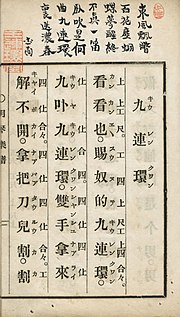On'yomi (音読み, [oɰ̃jomi], lit. "sound(-based) reading"), or the Sino-Japanese reading, is the reading of a kanji based on the historical Chinese pronunciation...
9 KB (852 words) - 18:34, 9 August 2024
Kanji (section On'yomi (Sino-Japanese reading))
kun'yomi "hatara(ku)" and the on'yomi "dō", and 腺 "gland", which has only the on'yomi "sen"—in both cases these come from the on'yomi of the phonetic component...
94 KB (9,715 words) - 18:12, 9 August 2024
some kokuji do have on'yomi. One such character is 働 (as in 働く hataraku, "to work"), which was given the on'yomi dō (from the on'yomi of its phonetic component...
133 KB (7,161 words) - 18:31, 9 August 2024
of three or even four syllables are not uncommon. This contrasts with on'yomi, which are monosyllabic, and is unusual in the Chinese family of scripts...
6 KB (781 words) - 18:34, 9 August 2024
of grouping by 10,000. Two pronunciations are used: the Sino-Japanese (on'yomi) readings of the Chinese characters and the Japanese yamato kotoba (native...
32 KB (2,590 words) - 04:48, 24 June 2024
"reading"), and some common kanji have many. These are broadly divided into on'yomi, which are readings that approximate to a Chinese pronunciation of the...
36 KB (4,203 words) - 03:40, 7 August 2024
gradually replaced by 日本, which was first pronounced with the Chinese reading (on'yomi) Nippon and later as Nifon, and then in modern usage Nihon, reflecting...
44 KB (4,518 words) - 03:38, 14 July 2024
pronounced with the kun'yomi mura. As a bound morpheme, it also has the on'yomi son, for example in the compounds shichōson (市町村, "cities, towns and villages")...
34 KB (315 words) - 00:00, 1 June 2024
Ontology, a branch of philosophy that deals with the concept of being On'yomi, reading of Japanese kanji characters Order of the Nation, a Jamaican honour...
3 KB (349 words) - 21:39, 19 July 2024
used in a visual search. There are two readings for a kanji: On'yomi and Kun'yomi. On'yomi is a reading derived from the Chinese way of reading, Kun'yomi...
39 KB (666 words) - 22:01, 1 August 2023
with tō-on (唐音, Tang sound), which were later phonetic loans. Kan-on are on'yomi (音読み) based on the central Chang'an pronunciation of Middle Chinese. The...
5 KB (238 words) - 19:07, 9 August 2024
clan"), or less frequently, the Genke (源家, "House of Minamoto"), using the On'yomi readings of gen (源) for "Minamoto", while shi or ji (氏) means "clan", and...
24 KB (2,449 words) - 03:42, 18 July 2024
"Taira clan") or Heike (平家, "House of Taira"), using the character's On'yomi hei (平) for Taira, while shi (氏) means "clan", and ke (家) is used as a...
11 KB (1,185 words) - 18:33, 4 August 2024
Japanese kun'yomi, while the Wakon (和魂 "Japanese spirit") reading is Sinitic on'yomi borrowed from Chinese Héhún (和魂). Yamato is historically the second of...
21 KB (2,743 words) - 03:06, 10 March 2024
Muda (無駄, on'yomi reading, ateji) is a Japanese word meaning "futility", "uselessness", or "wastefulness", and is a key concept in lean process thinking...
11 KB (1,404 words) - 18:14, 14 May 2024
Chinese-derived on'yomi pronunciations, for example in kanji dictionaries, the kun'yomi pronunciations are written in hiragana, and the on'yomi pronunciations...
23 KB (2,733 words) - 18:08, 9 August 2024
readings, known as on'yomi and kun'yomi respectively. Moreover, kanji may have multiple readings of either kind. Distinct classes of on'yomi were borrowed...
126 KB (14,267 words) - 21:25, 9 August 2024
eastern Jiankang (now Nanjing) dialect. Go-on are the earliest form of on'yomi (音読み), preceding the kan-on (漢音) readings. Both go-on and kan-on exhibit...
6 KB (691 words) - 13:34, 8 August 2024
compositions used two common types of Japanese kanji readings: Sino-Japanese on'yomi ('pronunciation readings') borrowed from Chinese pronunciations and native...
26 KB (2,868 words) - 15:13, 17 July 2024
order with an okurigana. In Japanese, the more formal seppuku, a Chinese on'yomi reading, is typically used in writing, while harakiri, a native kun'yomi...
45 KB (5,579 words) - 21:36, 19 July 2024
is taught in secondary school. The list is sorted by Japanese reading (on'yomi in katakana, then kun'yomi in hiragana), in accordance with the ordering...
375 KB (688 words) - 19:01, 9 August 2024
in Japanese, the logographic (Chinese-derived) reading is called the on'yomi reading, and the morphographic reading (native Japanese) is called the...
1 KB (138 words) - 03:40, 19 August 2023
position ceased to exist after the Muromachi period. The word shikken is the on'yomi reading of the combination of the two kanji characters 執 and 権, each meaning...
5 KB (602 words) - 02:07, 20 May 2024
The kai element also strongly resembles the On'yomi, or Sino-Japanese, reading of the characters 蝦夷 (on'yomi as [ka.i, カイ], kun'yomi as [e.mi.ɕi, えみし])...
140 KB (7,507 words) - 18:14, 9 August 2024
characters are pronounced in Japanese as 'Nagayoshi', by convention the on'yomi (Sino-Japanese reading) pronunciation of 'Chogi' is used for this smith...
29 KB (3,552 words) - 13:09, 29 May 2024
and 18th centuries, most notably the Bansenshūkai (1676). Ninja is the on'yomi (Early Middle Chinese–influenced) the two kanji "忍者". In the native kun'yomi...
79 KB (8,989 words) - 18:13, 9 August 2024
Zen monks and merchants during and after the Song dynasty, as a form of on'yomi (音読み). This period roughly corresponds with the mid-Heian to Edo periods...
2 KB (205 words) - 18:51, 9 August 2024
some of the characters may be pronounced using Chinese pronunciations (on'yomi, from Chinese morphemes), and others in the same word are pronounced using...
23 KB (1,902 words) - 01:03, 3 May 2024
pronounced with [p]. The kun'yomi pronunciation of the character 濁 (daku in on'yomi) is nigori; hence the daku-ten may also be called the nigori-ten. This...
12 KB (1,124 words) - 18:36, 9 August 2024
loose, Chinese-derived readings (on'yomi). For example, yama (山, mountain) would be spelt as 也末, with two magana with on'yomi for ya and ma; likewise, hito...
31 KB (2,933 words) - 18:09, 9 August 2024










